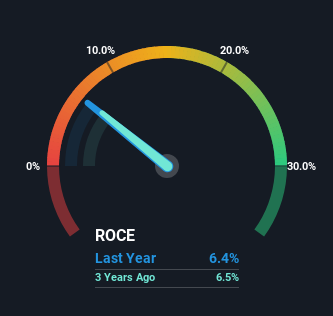Kinder Morgan's (NYSE:KMI) Returns Have Hit A Wall
Finding a business that has the potential to grow substantially is not easy, but it is possible if we look at a few key financial metrics. In a perfect world, we'd like to see a company investing more capital into its business and ideally the returns earned from that capital are also increasing. This shows us that it's a compounding machine, able to continually reinvest its earnings back into the business and generate higher returns. In light of that, when we looked at Kinder Morgan (NYSE:KMI) and its ROCE trend, we weren't exactly thrilled.
Understanding Return On Capital Employed (ROCE)
If you haven't worked with ROCE before, it measures the 'return' (pre-tax profit) a company generates from capital employed in its business. The formula for this calculation on Kinder Morgan is:
Return on Capital Employed = Earnings Before Interest and Tax (EBIT) ÷ (Total Assets - Current Liabilities)
0.064 = US$4.2b ÷ (US$71b - US$4.6b) (Based on the trailing twelve months to March 2024).
So, Kinder Morgan has an ROCE of 6.4%. In absolute terms, that's a low return and it also under-performs the Oil and Gas industry average of 13%.
Check out our latest analysis for Kinder Morgan
Above you can see how the current ROCE for Kinder Morgan compares to its prior returns on capital, but there's only so much you can tell from the past. If you'd like, you can check out the forecasts from the analysts covering Kinder Morgan for free.
The Trend Of ROCE
Over the past five years, Kinder Morgan's ROCE and capital employed have both remained mostly flat. It's not uncommon to see this when looking at a mature and stable business that isn't re-investing its earnings because it has likely passed that phase of the business cycle. So don't be surprised if Kinder Morgan doesn't end up being a multi-bagger in a few years time. On top of that you'll notice that Kinder Morgan has been paying out a large portion (88%) of earnings in the form of dividends to shareholders. Most shareholders probably know this and own the stock for its dividend.
The Bottom Line
In summary, Kinder Morgan isn't compounding its earnings but is generating stable returns on the same amount of capital employed. And investors may be recognizing these trends since the stock has only returned a total of 30% to shareholders over the last five years. As a result, if you're hunting for a multi-bagger, we think you'd have more luck elsewhere.
Kinder Morgan does come with some risks though, we found 3 warning signs in our investment analysis, and 2 of those make us uncomfortable...
If you want to search for solid companies with great earnings, check out this free list of companies with good balance sheets and impressive returns on equity.
Have feedback on this article? Concerned about the content? Get in touch with us directly. Alternatively, email editorial-team (at) simplywallst.com.
This article by Simply Wall St is general in nature. We provide commentary based on historical data and analyst forecasts only using an unbiased methodology and our articles are not intended to be financial advice. It does not constitute a recommendation to buy or sell any stock, and does not take account of your objectives, or your financial situation. We aim to bring you long-term focused analysis driven by fundamental data. Note that our analysis may not factor in the latest price-sensitive company announcements or qualitative material. Simply Wall St has no position in any stocks mentioned.

 Yahoo Finance
Yahoo Finance 
